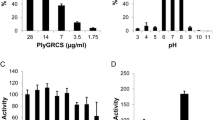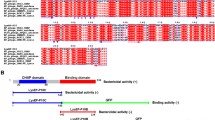Abstract
Group B streptococci (GBS) are the leading cause of neonatal meningitis and sepsis worldwide. Intrapartum antibiotic prophylaxis (IAP) is the current prevention strategy given to pregnant women with confirmed vaginal GBS colonization. Due to antibiotic resistance identified in GBS, we previously developed another strategy using a bacteriophage lytic enzyme, PlyGBS, to reduce vaginal GBS colonization. In this study, various DNA mutagenesis methods were explored to produce PlyGBS mutants with increased lytic activity against GBS. Several hyperactive mutants were identified that contain only the endopeptidase domain found in the N-terminal region of PlyGBS and represent only about one-third of the wild-type PlyGBS in length. Significantly, these mutants not only have 18–28-fold increases in specific activities compared to PlyGBS, but they also have a similar activity spectrum against several streptococcal species. One of the hyperactive mutants, PlyGBS90-1, reduced the GBS colonization from >5 logs of growth per mouse to <50 colony-forming units (cfu) 4 h post treatment (∼4-log reduction) using a single dose in a mouse vaginal model. A reduction in GBS colonization before delivery should significantly reduce neonatal GBS infection providing a safe alternative to IAP.






Similar content being viewed by others
References
Baker CJ, Edwards MS (2001) Group B streptococcal infections. In: Remmington J, Klein JO (eds) Infectious diseases of the fetus and newborn infants, 5th edn. The W. B. Saunders Co. Philadelphia, PA, pp 1091–1156
Campbell N, Eddy A, Darlow B, Stone P, Grimwood K; New Zealand GBS Consensus Working Party (2004) The prevention of early-onset neonatal group B streptococcus infection: technical report from the New Zealand GBS Consensus Working Party. N Z Med J 117(1200):U1023–U1029
Centers for Disease Control and Prevention (1996) Prevention of perinatal group B streptococcal disease: a public health perspective. Morb Mort Wkly Rep 45:1–24
Centers for Disease Control and Prevention (2002) Prevention of perinatal group B streptococcal disease: revised guidelines from CDC. Morb Mort Wkly Rep 51:1–22
Cheng Q, Nelson D, Zhu SW, Fischetti VA (2005) Removal of group B streptococci colonizing the vagina and oropharynx of mice with a bacteriophage lytic enzyme. Antimicrob Agents Chemother 49:111–117
Fernandez M, Hickman M, Baker CJ (1998) Antimicrobial susceptibilities of group B streptococci isolated between 1992 and 1996 from patients with bacteremia or meningitis. Antimicrob Agents Chemother 42:1517–1519
Hall RT, Barnes W, Krishnan W, Harris DJ, Rhodes PG, Fayez J, Miller GL (1976) Antibiotic treatment of parturient women colonized with group B streptococci. Am J Obstet Gynecol 124:630–634
Loeffler JM, Nelson D, Fischetti VA (2001) Rapid killing of Streptococcus pneumoniae with a bacteriophage cell wall hydrolase. Science 294:2170–2172
Lopez R, Garcia E, Garcia P, Garcia JL (1997) The pneumococcal cell wall degrading enzymes: a modular design to create new lysins? Microb Drug Resist 3:199–211
Low LY, Yang C, Perego M, Osterman A, Liddington RC (2005) Structure and lytic activity of a Bacillus anthracis prophage endolysin. J Biol Chem 280:35433–35439
McLean NW, Rosenstein IJ (2000) Characterization and selection of a Lactobacillus species to recolonize the vagina of women with recurrent bacterial vaginosis. J Med Microbiol 49:543–552
Nelson D, Loomis L, Fischetti VA (2001) Prevention and elimination of upper respiratory colonization of mice by group A streptococci by using a bacteriophage lytic enzyme. Proc Natl Acad Sci USA 98:4107–4112
Pritchard DG, Dong S, Baker JR, Engler JA (2004) The bifunctional peptidoglycan lysin of Streptococcus agalactiae bacteriophage B30. Microbiology 150:2079–2087
Regan JA, Klebanoff MA, Nugent RP, Eschenbach DA, Blackwelder WC, Lou Y et al (1996) Colonization with group B streptococci in pregnancy and adverse outcome. Am J Obstet Gynecol 174:1354–1360
Schuch R, Nelson D, Fischetti VA (2002) A bacteriolytic agent that detects and kills Bacillus anthracis. Nature 418:884–889
Acknowledgment
This work was supported in part by US Public Health Service grants AI-056510 and AI-057472. We particularly thank Bokai Xia for his assistance in statistical analysis. We also thank Jutta Loeffler and Daniel Nelson for reviewing the manuscript.
Author information
Authors and Affiliations
Corresponding author
Rights and permissions
About this article
Cite this article
Cheng, Q., Fischetti, V.A. Mutagenesis of a bacteriophage lytic enzyme PlyGBS significantly increases its antibacterial activity against group B streptococci. Appl Microbiol Biotechnol 74, 1284–1291 (2007). https://doi.org/10.1007/s00253-006-0771-1
Received:
Revised:
Accepted:
Published:
Issue Date:
DOI: https://doi.org/10.1007/s00253-006-0771-1




